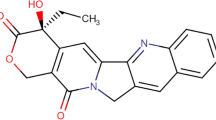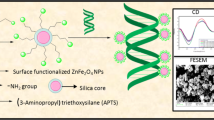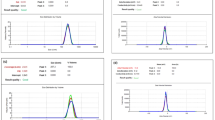Abstract
Peptides are reducing and capping agents that can be used for the synthesis of biocompatible metal nanoparticles under relatively mild conditions. However, the abundance of random and inactive amino acid sequences in peptides, the lack of peptide design rules have led to their studies being slow and make it difficult to use them. In this study, calcitonin-capped Au nanoparticles were synthesized by a simple and controlled method. The aim of this study was to determine the cytotoxicity of calcitonin-capped Au nanoparticles on the human breast cancer cells (MCF-7) and osteoblast cell lines (G292). The absorbance of calcitonin-capped Au nanoparticles is higher than bare AuNPs. FTIR analysis revealed that amino acides of present in calcitonin played dual roles as reducing and stabilizing agents during synthesis of AuNPs. TEM image analysis showed formation of predominantly spherical calcitonin-capped Au nanoparticles with mean particle diameter of about 2–20 nm. The interactions between the calcitonin-capped Au nanoparticles and calf thymus DNA in aqueous was studied by circular dichroism (CD), UV–Vis and fluorescence spectroscopy. The results indicated that the synthesized calcitonin-capped Au nanoparticles can successfully insert into calf thymus DNA. [L]1/2, concentrations of calcitonin-capped Au nanoparticles in the midpoint of transition, 0.32085 mM and o.28744 mM and the apparent binding constant (K × 104(M)−1), 79.52 and 81.04 were obtained at 300 and 310 K, respectively. The cytotoxicity of the prepared calcitonin-capped Au nanoparticles was measured on the human breast cancer cells (MCF-7) and osteoblast cell lines (G292) by cell viability (MTT assay) and apoptosis (TUNEL assay: Terminal deoxynucleotidyl transferase dUTP nick end labeling). According to the MTT assay, the CC50 values of calcitonin-capped Au nanoparticles and cisplatin are 12.7 μM and 8.3 μM, respectively in G292 which are very near to each other compared on MCF-7. Therefore, TUNEL assay was done on G292 cell lines. The results showed that apoptosis was obviously observable by 48% DNA fragmentation on G292 cell lines. Therefore, the calcitonin-capped Au nanoparticles are suitable drugs which have strong potential in DNA denaturation and apoptosis especially on osteoblast cell lines (G292).
Graphical Abstract


















Similar content being viewed by others
References
S. Ahmadian-Fard-Fini, D. Ghanbari, O. Amiri, and M. Salavati-Niasari (2020). Electro-spinning of cellulose acetate nanofibers/Fe/carbon dot as photoluminescence sensor for mercury (II) and lead (II) ions. Carbohydr. Polym. 229, 115428.
S. Ahmadian-Fard-Fini, D. Ghanbari, and M. Salavati-Niasari (2019). Photoluminescence carbon dot as a sensor for detecting of Pseudomonas aeruginosa bacteria: hydrothermal synthesis of magnetic hollow NiFe2O4-carbon dots nanocomposite material. Compos. Part B 161, 564–577.
S. Ahmadian-Fard-Fini, M. Salavati-Niasari, and D. Ghanbari (2018). Hydrothermal green synthesis of magnetic Fe3O4–carbon dots by lemon and grape fruit extracts and as a photoluminescence sensor for detecting of E. coli bacteria. Spectrochim Acta A 203, 481–493.
M. Yoshida and J. Lahann (2008). Smart nanomaterials. ACS Nano. 2, 1101–1107.
T. M. Allen and P. R. Cullis (2004). Drug delivery systems: entering the mainstream. Science. 303, 1818–1822.
B. K. Lee, Y. H. Yun, and K. Park (2015). Smart nanoparticles for drug delivery: boundaries and opportunities. Chem. Eng. Sci. 125, 158–164.
D. Liu, F. Yang, F. Xiong, and N. Gu (2016). The smart drug delivery system and its clinical potential. Theranostics. 6, 1306–1323.
D. Peer, J. M. Karp, S. Hong, O. C. Farokhzad, R. Margalit, and R. Langer (2007). Nanocarriers as an emerging platform for cancer therapy. Nat. Nanotechnol. 2, 751–760.
E. S. Kawasaki and A. Player (2005). Nanotechnology, nanomedicine, and the development of new, effective therapies for cancer. Nanomed. Drug Deliv. 1, 101–109.
B. Aslan, B. Ozpolat, A. K. Sood, and G. Lopez-Berestein (2013). Nanotechnology in cancer therapy. J. Drug Targeting. 21, 904–913.
X. Yu, I. Trase, M. Ren, K. Duval, X. Guo, and Z. Chen. (2016) Design of nanoparticle-based carriers for targeted drug delivery. J. Nanomater.
J. Yin, Y. Chen, Z. H. Zhang, and X. Han (2016). Stimuli-responsive block copolymer-based assemblies for cargo delivery and theranostic applications. Polymers. 8, 268–315.
E. L. Siegler, Y. J. Kim, and P. Wang (2016). Nanomedicine targeting the tumor microenvironment: therapeutic strategies to inhibit angiogenesis, remodel matrix, and modulate immune responses. J. Cell. Immunother. 2, 69–78.
M. Werner, T. Auth, P.A. Beales (2018) Nanomaterial interactions with biomembranes: bridging the gap between soft matter models and biological context. Biointerphases 13
P. Ghosh, G. Han, M. De, C. Kim, and V. Rotello (2008). Gold nanoparticles in delivery applications. Adv. Drug Deliv. Rev. 60, 1307–1315.
F.Y. Kong, J. W. Zhang, R.F. Li, Z.X. Wang, W.J. Wang, W. Wang (2017) Unique roles of gold nanoparticles in drug delivery, targeting and imaging applications. Molecules 22
T. V. Verissimo, N. T. Santos, J. R. Silva, R. B. Azevedo, A. J. Gomes, and C. N. Lunardi (2016). In vitro cytotoxicity and photo toxicity of surface-modified gold nanoparticles associated with neutral red as a potential drug delivery system in phototherapy. Mater. Sci. Eng. C 65, 199–204.
K. Sreejivungsa, N. Suchaichit, P. Moosophon, and A. Chompoosor (2016). Light-regulated release of entrapped drugs from photoresponsive gold nanoparticles. J. Nanomater.. Article ID 4964693, 1–7.
E. Maltas, S. Malkondu, P. Uyar, and M. Ozmen (2015). Fluorescent labelling of DNA on superparamagnetic nanoparticles by a perylene bisimide derivative for cell imaging. Mater. Sci. Eng. C 48, 86–93.
Y. Zhai, Y. Zhang, F. Qin, and X. Yao (2015). An electrochemical DNA biosensor for evaluating the effect of mix anion in cellular fluid on the antioxidant activity of CeO2 nanoparticles. Biosens. Bioelectron. 70, 130–136.
T. J. Daou, L. Li, P. Reiss, V. Josserand, and I. Texier (2009). Effect of poly (ethylene glycol) length on the in vivo behavior of coated quantum dots. Langmuir. 25, 3040–3044.
E. B. Voura, J. K. Jaiswal, H. Mattoussi, and S. M. Simon (2004). Tracking metastatic tumor cell extravasation with quantum dot nanocrystals and fluorescence emission-scanning microscopy. Nat. Med. 10, 993–998.
A. Kumar (2013). Innovative pharmaceutical development based on unique properties of nanoscale delivery formulation. Nanoscale. 5, 8307–8325.
C. Ding, A. Zhu, and Y. Tian (2014). Functional surface engineering of C-dots for fluorescent biosensing and in vivo bioimaging. Acc. Chem. Res. 47, 20–30.
D. E. Cliffel, F. P. Zamborini, S. M. Gross, and R. W. Murray (2000). Silver, and palladium clusters. Langmuir. 16, 9699–9702.
S. Mann, B.R. Heywood, S. Rajam, and V.J. Wade (1991) Molecular recognition in biomineralization. In Mechanisms and Phylogeny of Mineralization in Biological Systems. Springer, Tokyo, pp. 47−55
G. Zan and Q. Wu (2016). Biomimetic and bioinspired synthesis of nanomaterials/nanostructures. Adv. Mater. 28, 2099–2147.
B. D. Briggs, Y. Li, M. T. Swihart, and M. R. Knecht (2015). Reductant and sequence effects on the morphology and catalytic activity of peptide capped Au nanoparticles. ACS Appl. Mater. Interfaces 7, 8843–8851.
W. Yang, W. Guo, J. Chang, and B. Zhang (2017). Protein/peptide templated biomimetic synthesis of inorganic nanoparticles for biomedical applications. J. Mater. Chem. B 5, 401–417.
H. Duan, D. Wang, and Y. Li (2015). Green chemistry for nanoparticle synthesis. Chem. Soc. Rev. 44, 5778–5792.
J. M. Patete, X. Peng, C. Koenigsmann, Y. Xu, B. Karn, and S. S. Wong (2011). Viable methodologies for the synthesis of high-quality nanostructures. Green Chem. 13, 482–519.
S. Zhang (2003). Fabrication of novel biomaterials through molecular self-assembly. Nat. Biotechnol. 21, 1171–1178.
C. L. Chen and N. L. Rosi (2010). Peptide-based methods for the preparation of nanostructured inorganic materials. Angew. Chem. Int. Ed. 49, 1924–1942.
N. M. Bedford, Z. E. Hughes, Z. Tang, Y. Li, B. D. Briggs, Y. Ren, M. T. Swihart, V. G. Petkov, R. R. Naik, M. R. Knecht, and T. R. Walsh (2016). Sequence-dependent structure/function relationships of catalytic peptide-enabled gold nanoparticles generated under ambient synthetic conditions. J. Am. Chem. Soc. 138, 540–548.
S. Deshayes, M. Morris, F. Heitz, and G. Divita (2008). Delivery of proteins and nucleic acids using a non-covalent peptide-based strategy. Adv. Drug Deli. Rev. 60, 537–547.
M. Arsianti, M. Lim, C. P. Marquis, and R. Amal (2010). Assembly of polyethylenimine-based magnetic iron oxide vectors: insights into gene delivery. Langmuir. 26, 7314–7326.
S. Guo, Y. Huang, Q. Jiang, Y. Sun, L. Deng, Z. Liang, Q. Du, J. Xing, Y. Zhao, P. C. Wang, A. Dong, and X. J. Liang (2010). Enhanced gene delivery and siRNA silencing by gold nanoparticles coated with charge-reversal polyelectrolyte. ACS Nano 4, 5505–5511.
J. L. West and N. J. Halas (2000). Applications of nanotechnology to biotechnology: commentary. Curr. Opin. Biotechnol. 11, 215–217.
M. Tsoli, H. Kuhn, W. Brandau, H. Esche, and G. Schmid (2005). Cellular uptake and toxicity of Au55 clusters. Small 1, 841–844.
W. Wang, Q. Wei, J. Wang, B. Wang, S. Zhang, and Z. Yuan (2013). Role of thiol-containing polyethylene glycol (thiol-PEG) in the modification process of gold nanoparticles (AuNPs): stabilizer or coagulant. J. Colloid Interface Sci. 404, 223–229.
R. Levy (2006). Peptide-capped gold nanoparticles: towards artificial proteins. Chem. Eur. 7, 1141–1145.
Z. Wang, R. Levy, D. G. Fernig, and M. Brust (2006). Kinase-catalyzed modification of gold nanoparticles: a new approach to colorimetric kinase activity screening. J. Am. Chem. Soc. 128, 2214–2215.
S. P. A. Toledo, D. M. Lourenço, M. A. Santos, M. R. Tavares, R. A. Toledo, and J. E. De Menezes Correia-Deur (2009). Hyper-calcitoninemia is not pathognomonic of medullary thyroid carcinoma. Clinics 64, 699–706.
P. Trimboli, L. Guidobaldi, M. Bongiovanni, A. Crescenzi, M. Alevizaki, and L. Giovanella (2016). Use of fine-needle aspirate calcitonin todetect medullary thyroid carcinoma: a systematic review. Diagn. Cytopathol. 44, 45–51.
M. D’Hondt, D. M. Van, B. Mehuys, D. Deforce, and B. DeSpiegeleer (2010). Quality analysis of salmon calcitonin in a polymericbioadhesive pharmaceutical formulation: sample preparation opti-mization by DOE. J. Pharm. Biomed. Anal. 53, 939–945.
M. Eslami Moghadam, M. Saidifar, A. Divsalar, H. Mansouri-Torshizi, A. A. Saboury, H. Farhangian, and M. Ghadamgahi (2016). Rich spectroscopic and molecular dynamic studies on the interaction of cytotoxic Pt (II) and Pd (II) complexes of glycine derivatives with calf thymus DNA. J. Biomol. Struct. Dyn. 34, 206–222.
H. Mansouri-Torshizi, E. Rezaei, F. Kamranfar, and M. H. Majd (2016). Investigating the apoptosis ability of ethylenediamine 8-hydroxyquinolinato palladium (II) complex. Adv. Pharm. Bull. 6, 449–453.
M. Heidari Majd, A. Akbarzadeh, and A. Sargazi (2017). Evaluation of host–guest system to enhance the tamoxifen efficiency. Artif. Cells Nanomed. Biotechnol. 45, 441–447.
A. Sargazi, K. Kuhestani, T. Nosrat Nahoki, and M. Heidari Majd (2015). Specific targeting of folate receptor by methotrexate conjugated modified magnetic nanoparticles: enzymatic release and cytotoxic study. Int. Jo. Pharm. Sci. Res. 6, 5047–5055.
K. Lance Kelly, E. Coronado, L. L. Zhao, and G. C. Schatz (2003). The optical properties of metal nanoparticles: the influence of size, shape, and dielectric environment. J. Phys. Chem. B 107, 668.
J. Won, K. J. Ihn, and Y. S. Kang (2002). Gold nanoparticle patterns on polymer films in the presence of poly (amidoamine) dendrimers. Langmuir. 18, 8246–8254.
B. Nikoobakht and M. A. El-Sayed (2003). Preparation and growth mechanism of gold nanorods (NRs) using seed-mediated growth method. Chem. Mater. 15, 1957–1963.
M. K. Cobierre, N. S. Cameron, and R. B. Lennox (2004). Polymer-stabilized gold nanoparticles with high grafting densities. Langmuir. 20, 2867–2878.
M. J. Hostetler, J. E. Wingate, C. J. Zhong, J. E. Harris, R. W. Vachet, M. R. Clark, J. D. Londono, S. J. Green, J. J. Stokes, G. D. Wignall, G. L. Glish, M. D. Porter, N. D. Evans, and R. W. Murray (1998). Alkanethiolate gold cluster molecules with core diameters from 1.5 to 5.2 nm: core and monolayer properties as a function of core size. Langmuir 14, 17–26.
R. West, Y. Wang, and T. Goodson (2003). Nonlinear absorption properties in novel gold nanostructured topologies. J. Phys. Chem. B 107, 3419–3431.
S. K. Ghosh and T. Pal (2007). Interparticle coupling effect on the surface plasmon resonance of gold nanoparticles: from theory to applications. Chem. Rev. 107, 4797–4862.
S. Aryal, B. K. Remant, N. Dharmaraj, N. Bhattarai, C. H. Kim, and H. Y. Kim (2006). Study of electrolyte induced aggregation of gold nanoparticles capped by amino acids. J. Colloid Interface Sci. 299, 191–197.
P. Zhang, J. Li, D. Liu, Y. Qin, Z. X. Guo, and D. Zhu (2004). Self-assembly of gold nanoparticles on fullerene nanospheres. Langmuir. 20, 1466–1479.
Z. Sorinezami, H. Mansouri-Torshizi, M. Aminzadeh, A. Ghahghaei, N. Jamgohari, and M. Heidari Majd (2017). Synthesis of new ultrasonic-assisted palladium oxide nanoparticles: an in vitro evaluation on cytotoxicity and DNA/BSA binding properties. J. Biomol. Struct. Dyn. 37, 4238–4250.
Z. Sorinezami, H. Mansouri-Torshizi, and B. Ghanbari (2017). Synthesis of PdO nanoparticles: crystal structure, DNA binding, and cytotoxicity of a new hydroxyl-quinolinato-palladium complex. Inorg. Nano-Metal Chem. 47, 500–508.
A. V. Hill (1910). The possible effects of the aggregation of the molecules of haemoglobin on its dissociation curves. J. Physiol. 40, 4–7.
S. Shahraki, F. Shiri, M. H. Majd, and Z. Razmara (2017). Comparative study on the anticancer activities and binding properties of a hetero metal binuclear complex [Co(dipic)2 Ni(OH2) 5]·2H2O (dipic=dipicolinate) with two carrier proteins. J. Pharm. Biomed. Anal. 145, 273–282.
S. Shahraki, H. Mansouri-Torshizi, Z. S. Nezami, A. Ghahghaei, F. Yaghoubi, A. Divsalar, and F. H. Shirazi (2014). The effects of extending of co-planarity in a series of structurally relative polypyridyl Palladium (II) complexes on DNA-binding and cytotoxicity properties. Iran. J. Pharm. Res. 13, 1279–1294.
G. Scatchard (1949). The attractions of proteins for small molecules and ions. Ann. N. Y. Acad. Sci. 51, 660–672.
Z. Sorinezami and H. Mansouri-Torshizi (2016). Photo-catalytic degradation of organic dyes: ultrasonic-assisted synthesis of PdO nanoparticles. J. Mater. Sci. 27, 1558–1565.
M. Howe-Grant, K. C. Wu, W. R. Bauer, and S. J. Lippard (1976). Binding of platinum and palladium metallointercalation reagents and antitumor drugs to closed and open DNAs. Biochemistry 15, 4339–4346.
G. Zhang, Y. Ma, L. Wang, Y. Zhang, and J. Zhou (2012). Multi spectroscopic studies on the interaction of maltol, a food additive, with bovine serum albumin. Food Chem. 133, 264–270.
E. Ramachandran, D. S. Raja, N. S. Bhuvanesh, and K. Natarajan (2013). Synthesis, characterization and in vitro pharmacological evaluation of new water soluble Ni(II) complexes of 4N-substituted thiosemicarbazones of 2-oxo-1,2-dihydroquinoline-3-carbaldehyde. Eur. J. Med. Chem. 64, 179–189.
F. L. Cui, J. Fan, D. L. Ma, M. C. Liu, X. G. Chen, and Z. D. Hu (2003). A study of the interaction between a new reagent and serum albumin by fluorescence spectroscopy. Anal. Lett. 36, 2151–2166.
M. T. Behnamfar, H. Hadadzadeh, J. Simpson, F. Darabi, A. Shahpiri, T. Khayamian, and M. Salimi (2015). Experimental and molecular modeling studies of the interaction of the polypyridyl Fe (II) and Fe (III) complexes with DNA and BSA. Spectrochim. Acta A 134, 502–516.
H. Khan, A. Badshah, G. Murtaz, M. Said, Zu. Rehman, C. Neuhausen, and I. S. Butler (2011). Synthesis, characterization and anticancer studies of mixed ligand dithiocarbamate palladium (II) complexes. Eur. J. Med. Chem. 46, 4071–4077.
S. J. Yang, M. C. Liu, H. M. Xiang, Q. Zhao, W. Xue, and S. Yang (2015). Synthesis and in vitro antitumor evaluation of betulin acid ester derivatives as novel apoptosis inducers. Eur. J. Med. Chem. 102, 249–255.
E. Ulukaya, F. M. Frame, B. Cevatemre, D. Pellacani, H. Walker, V. M. Mann, and N. J. Maitland (2013). Differential cytotoxic activity of a novel palladium-based compound on prostate cell lines, primary prostate epithelial cells and prostate stem cells. PLOS ONE. 8, 1–13.
Z.M.J. Martinez, F.M. Roqué, C. Elena, R. Yuani, C. P. Alonso (2006) Calcitonin for metastatic bone pain. https://doi.org/10.1002/14651858.CD003223.pub2.
J. V. Jokerst, T. Lobovkina, R. N. Zare, and S. S. Gambhir (2011). Nanoparticle PEGylation for imaging and therapy. Nanomedicine 6, 715–728.
A. Sun, J. Deng, G. Guan, S. Chen, Y. Liu, J. Cheng, Z. Li, X. Zhuang, F. Sun, and H. Deng (2012). Dipeptidyl peptidase-IV is a potential molecular biomarker in diabetic kidney disease. Diabetes Vasc. Dis. Res. 9, 301–308.
K. Omidfar and M. Daneshpour (2015). Advances in phage display technology for drug discovery. Expert Opin. Drug Discov. 10, 651–669.
Acknowledgements
The authors would like to acknowledge the University of Zabol for funding this work (Research Grant No.: IR-UOZ-GR-5721 and No.: UOZ-GR-9517-5).
Author information
Authors and Affiliations
Corresponding authors
Additional information
Publisher's Note
Springer Nature remains neutral with regard to jurisdictional claims in published maps and institutional affiliations.
Rights and permissions
About this article
Cite this article
Davoodi, H., Sorinezami, Z., Moghaddam, M.G. et al. Smart Peptide/Au Nano-carriers for Drug Delivery Systems: Synthesis and Characterization, Interactions with Calf Thymus DNA, and In Vitro Cytotoxicity Studies. J Clust Sci 34, 451–465 (2023). https://doi.org/10.1007/s10876-022-02229-2
Received:
Accepted:
Published:
Issue Date:
DOI: https://doi.org/10.1007/s10876-022-02229-2




